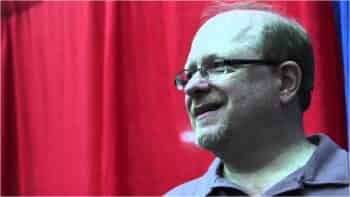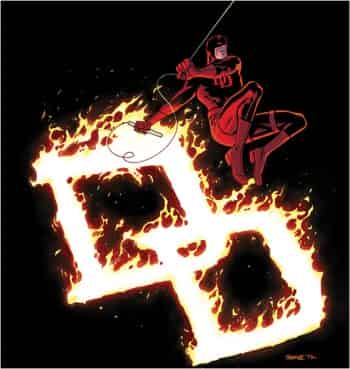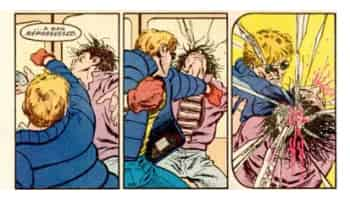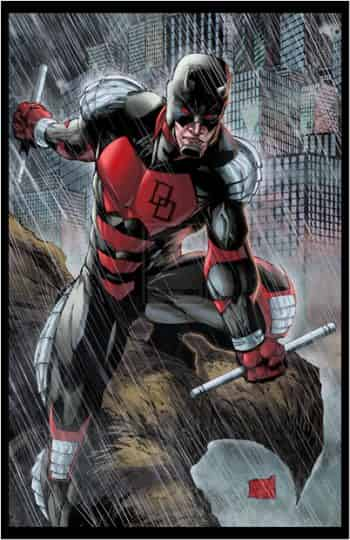
Daredevil
Mark Waid’s era in the Daredevil series
“To me, this run isn’t just the best ‘Daredevil’ run of all time (and that’s saying a lot)—it’s also one of the best comics, ever,” said Christine Hanefalk (“In Your Face Jam: Thanks For Making Me Cry, Daredevil, “», http://www.comicbookresources.com, September 2, 2015). We wish we’d said it first. We’ve repeatedly praised Mark Waid’s writing style. He’s an author we discovered with the Daredevil series, and we still believe he was in perfect symbiosis with his subject, creating one of the most organic stories, one that avoided tons of typical comic book pitfalls.
To fully understand the life that Waid breathed into this character, we have to remember the basic material he had to work with: “For years, Daredevil had been one of Marvel’s grimmest comics. Recent years had seen Daredevil outed as Matt Murdock at the hands of the Kingpin, loved ones murdered or driven insane by various villains, a stint in prison, and even a brief possession by a demon. When Mark Waid and artist Paolo Rivera took over Daredevil in 2011, many wondered how the two creators would destroy Murdock’s life next. The answer: they’d make Daredevil happy.
“The creator’s Daredevil run marked a return to the fun, swashbuckling superhero adventures not seen in a Daredevil book since the Silver Age. Not only did Daredevil beat gangsters and supervillains without losing loved ones or suffering personal tragedy in the process, he did it with a smile, pursuing life with a newfound optimism and bravado. For months, Daredevil readers waited for the other shoe to drop, because this was a Daredevil series and Matt Murdock could only experience so much good in his life before the Kingpin showed up at his doorstep and beat him half to death. But the wins kept piling up for Daredevil and while Matt’s personal life was a mess, he wasn’t adding to his problems with his typical self-destructive behavior. For the first time in years, Daredevil was a “fun” comic, a relative rarity in a genre filled with serious and straightforward takes on superheroes.” (Christian Hoffer, “A Look Back at Waid and Samnee’s Daredevil and Its Importance to Modern Comics,” http://comicbook.com, September 12, 2015). Despite this shift, Christine Hanefalk recalls that Waid never claimed that Matt Murdock’s depression was resolved. It was always there, and the hero just had to learn to live with it instead of making it a focal point of the story. “Waid shows that superhero stories can still tell serious stories without being dark and brooding” (Dylan Routledge, “The Weekly Challenge: Mark Waid,” http://www.comicbookdaily.com, October 12, 2015).
Aside from this shift in the character (while still remaining fundamentally faithful to it), the concept used, the reconnection, the homage to the Silver Age, was done in a very modern way: “Waid himself also contributes to the nostalgic mood of Daredevil, particularly with his choice of focus and guest characters. As well as bringing back old foes like Stiltman or the Jester or the Spot, he makes a point to focus on characters and concepts that feel tied and rooted in the sixties. Hank Pym is a recurring guest star, with the “hip scientist” and ant motif that defined the character in his earliest appearances. Indeed, Pym provides a link to the classic Avengers universe, nostalgically observing how things have changed. It’s not like the old days of the Avengers where everyone’s a casual identicard call away.” (Darren, “Mark Waid, Chris Samnee, Paolo Rivera et al.’s Run on Daredevil (Vol. 3) (Review/Retrospective),” https://them0vieblog.com, April 24, 2014).
This approach wasn’t loved by everyone. No one can achieve universal approval. “Reading the book feels more like something from the early 1960s than something modernized…” Andrew Ardizzi, «Daredevil # 7», https://www.comicbookdaily.com, December 26, 2011).
As is surely clear, we don’t agree with this last comment. An homage to sixties’ style would have resulted in overwriting, it would have made the topic of the story clear and unambiguous. But Waid lets the story speak for itself, and lets readers interpret the characters’ motives for themselves. For us, this style of writing is something to learn from and is a constant source of inspiration.
Collaboration between writers and illustrators
We have already spoken of the symbiosis that exists between words and illustration, but the relationship can sometimes be even more profound. Take, for example, the collaboration between Frank Miller and David Mazzucchelli for the Daredevil series in the 1980s. Nadel says, “Very simply, the story follows Matt Murdoch/Daredevil as his life is dismantled by his nemesis, The Kingpin. He loses faith in himself and the world, then regains it. Miller conceived the story and then he and Mazzucchelli collaborated very closely, as described by the artist in his unexpectedly candid and moving introduction: ‘This is why we chose not to separate the credits into writer and artist; because although technically I did no scripting and Frank did no drawing, I was contributing ideas for plot, characterization, and storytelling (such as the succession of title pages charting Matt’s descent), while Frank was describing the contents of each panel in his scripts’ ” (“Some Thoughts on David Mazzucchelli’s Daredevil: Born Again Artist’s Edition,” Dan Nadel, www.tcj.com, August 27, 2012).
To illustrate, when Michel Lamontagne suggested that we write a story from the point of view of the villains, we found the concept interesting. This resulted in “Blitzkrieg.” This story puts a face to some of the characters who often remain anonymous, and shows some of the human repercussions of the Black Orchestra’s attacks.
Mark Waid
Mark Waid is an author we only got to know recently through his work on Daredevil, which really impressed us. His stories seem almost “anticlimactic.” For example, in the seventh issue, Daredevil faces a snowstorm. And issue 12 is focused on the time when Matt and Foggy were studying law and had a confrontation with their teacher. The fight scenes are relatively short and rarely occupy a whole issue.
Curiously, without seeming spectacular at first glance, Mark Waid’s writing is stimulating and these issues are some we often reread. We also recently learned that Mark Waid doubles as a thinker on the impact of the Internet on comic production.
Which tone to use?
Corey Schroeder reminds us that “Fast-forward to the 90s and you’ve got a new kind of Batman. Watchmen and The Dark Knight Returns have reinvented superheroes as real people with real flaws in the midst of stories that treat the audience’s intellect with maturity” (“Are Superhero Comics Too Serious,” www.comicvine.com, September 14, 2011). Chris Sims goes even further: “The imitators learned the wrong lessons, and instead of creating stories that treated their subject matter with intelligence and craft, which is a difficult matter requiring a great deal of skill, the knock-offs tried to recapture the things that were easy, like cussin’ and violence. They were exactly the same kind of escapist power fantasy that they were pretending to rise above, just wrapped up in cheap, meaningless exploitation and sold to the audience as something that wasn’t for little kids — which in itself is the most immature, teenage motivation something can possibly have” (“What’s Up with the 90s?” www.comicsalliance.com, July 27, 2012).
This may explain why some people wonder if superhero stories have become too violent (“Sex & Violence,” www.comicbookdaily.com, December 9, 2011). In our opinion, violence isn’t the real problem. In the 90s, Frank Miller’s Daredevil stories included some very graphic representations of violence. But they fit the mood. Our main reproach would be the lack of perspective about that violence. If we take the TV series 24, Jack Bauer tortured criminals but we don’t recall any innocent characters being tortured. We feel more uneasy about that situation than about the torture itself.
Event Creation
As we have said in the past, changing authors is often used as a way to boost sales for a series. But a new author isn’t always enough and so an event must be created. Chichester admitted as much in an interview where he explained that the change in Daredevil’s costume in the early 1990s was a way to attract readers’ attention to the series and to position other changes in tone that they wanted to introduce (“Interview With D.G. Chichester (February 1998),” www.manwithoutfear.com).
However, these media events are now often clichéd. Readers know very well that the death of a major character is only a momentary eclipse to prepare their return. Like Graeme McMillan said: “It doesn’t help that it’s War in these teasers, a word that has similar weight at Marvel as “Crisis” does for DC. Between Secret War, Ultimate War, Civil War, Silent War, Chaos War and countless other wars that I’ve probably forgotten about (Oh! War of Kings, of course), the word has become almost meaningless in its attempt to suggest epic bombast, just like… Well, like the sight of Cap’s shield either cracked or splattered with blood, really. There’s an amazing sense of déjà vu from these trailers that’s unfortunate, especially considering that Avengers Vs. X-Men was already treading in ‘Haven’t I seen superheroes punching each other a lot recently in Civil War and X-Men: Schism?’ waters” (“I Don’t Wanna Live a War That’s Got Not End in Our Time,” www.newsarama.com, June 26, 2012).








